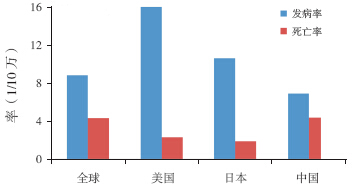 PDF(1342 KB)
PDF(1342 KB)


 PDF(1342 KB)
PDF(1342 KB)
 PDF(1342 KB)
PDF(1342 KB)
我国儿童恶性肿瘤的流行病学分析
Epidemiological analysis of childhood cancer in China
目的 分析我国儿童恶性肿瘤的流行病学特点,以期为儿童恶性肿瘤的相关研究和防控战略的制定和防控体系的构建提供线索和依据。方法 以2009~2012 年发布的“中国肿瘤登记年报”及GLOBOCAN2012 数据库中0~14 周岁儿童恶性肿瘤的发病和死亡数据为分析资料,对我国儿童恶性肿瘤的发病率和死亡率在时间、地区、年龄、性别等方面的分布进行描述性统计分析。结果 (1)时间分布:我国儿童恶性肿瘤的发病率随时间呈小幅波动,而死亡率基本稳定。(2)地区分布:我国的发病率低于世界平均水平,且明显低于美国和日本,而我国的死亡率却高于美国和日本;我国城市的发病率约为农村的2 倍,而死亡率相差不大。(3)年龄分布:随着年龄增加,发病率和死亡率总体呈下降趋势。(4)性别分布:男性的发病率和死亡率大于女性。结论 我国儿童恶性肿瘤的发病率和死亡率在时间、地区、年龄、性别等方面均呈现出特定的分布特点,分析其流行病学分布规律可明确儿童恶性肿瘤未来的研究方向,并为综合防控提供一定思路。
Objective To analyze the epidemiological features of childhood cancer in China, and to provide some clues and basis for related academic research, the formulation of prevention and control strategy, and the construction of prevention and control system of childhood cancer. Methods The data of childhood cancer in children aged 0-14 years which were published in Chinese Cancer Registry Annual Report in 2009-2012 and from GLOBOCAN2012 database were collected. A descriptive statistical analysis was done to determine the distributions of incidence and mortality by time, area, age, and sex. Results In China, the incidence of childhood cancer showed a slight fluctuation with time, while the mortality rate remained stable. The incidence of childhood cancer in China was lower than the world average, and it was much lower than in the United States and Japan. However, the mortality of childhood cancer in China was higher than that in the United States and Japan. The incidence of childhood cancer in Chinese urban areas was about 2 times that in Chinese rural areas, while the mortality in the urban and rural areas was similar. The incidence and the mortality of childhood cancer both declined with increasing age. The incidence and the mortality of childhood cancer in boys were higher than those in girls. Conclusions The incidence and mortality of childhood cancer in China show distribution characteristics by time, area, age, and sex, which can help to make clear the future direction of childhood cancer research and provide some ideas for the comprehensive prevention and control.

Cancer / Epidemiology / Child
[1] Kaatsch P. Epidemiology of childhood cancer[J]. Cancer Treat Rev, 2010, 36(4): 277-285.
[2] 鲍萍萍, 郑莹, 金凤. 儿童恶性肿瘤的环境危险因素研究进 展[J]. 环境与职业医学, 2008, 25(2): 190-194.
[3] GLOBOCAN2012: Estimated Cancer Incidence, Mortality and Prevalence Worldwide in 2012[DB/OL]. [March 2015]. http:// globocan.iarc.fr/Pages/age-specific_table_sel.aspx.
[4] National Cancer Institute. SEER Cancer Statistics Review, 1975-2010[EB/OL]. [June 14, 2013]. http://seer.cancer.gov/ csr/1975_2010.
[5] 鲍萍萍, 郑莹, 王春芳, 等. 2002-2004 年上海市儿童恶性肿 瘤发病特征[J]. 中国肿瘤, 2009, 18(2): 119-122.
[6] 王新正, 元芳梅, 张永贞, 等. 1998~2007 年阳城县儿童恶性 肿瘤发病率分析[J]. 中国肿瘤, 2012, 21(8): 583-585.
[7] 曹卡加, 刘奕龙, 马国胜. 广州市城区2000~2004 年儿童恶 性肿瘤发病和死亡率分析[J]. 癌症, 2010, 29(3): 359-362.
[8] 宋凯, 陈仁华, 刘庆敏, 等. 杭州市儿童恶性肿瘤的发病特 征研究[J]. 浙江预防医学, 2013, 25(3): 15-17.
[9] Baba S, Ioka A, Tsukuma H, et al. Incidence and survival trends for childhood cancer in Osaka, Japan, 1973-2001[J]. Cancer Sci, 2010, 101(3): 787-792.
[10] Ljungman G, Jakobson A, Behrendtz M, et al. Incidence and survival analyses in children with solid tumors diagnosed in Sweden between 1983 and 2007[J]. Acta Paediatr, 2011, 100(5): 750-757.
中国工程院咨询研究项目“中国儿童恶性肿瘤防控战略综合研究”(2014-XZ-13)。